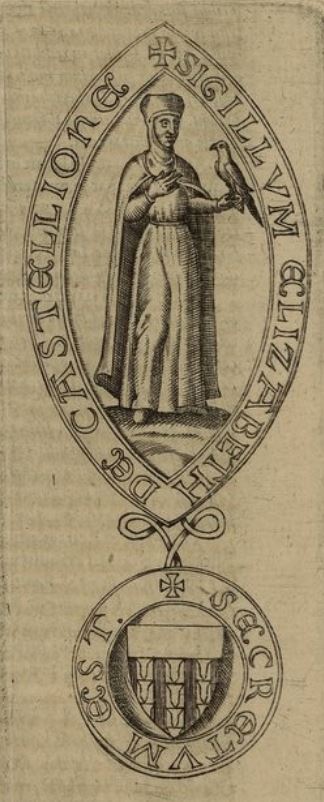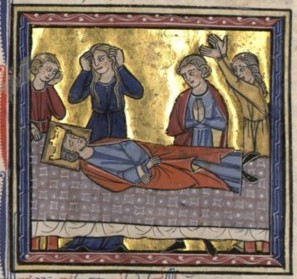|
William II, Lord Of Béthune
William II, Lord of Béthune, nicknamed ''William the Red'' (french: links=no, Guillaume II « le Roux » de Bethune; d. April 1214) was French nobleman. He was a ruling Lord of Béthune, Richebourg and Warneton, as well as hereditary ''advocatus'' of the Abbey of St. Vaast, near Arras. Family He was a member of the influential House of Bethune, who had their ancestral seat in Béthune in the Artois region. He was the second son of Lord Robert V, nicknamed ''Robert the Red'', and his wife Adelaide of Saint-Pol. His brothers were: * Robert VI (d. 1193) * Baldwin (d. 1212) * Conon (d. 1219 or 1220), a famous troubadour and crusader * Jean (d. 1219), bishop of Cambrai Life William II and his elder brother Robert VI accompanied their father in the armed escort of Count Philip I of Flanders when he made a pilgrimage to the Holy Land in 1177. When they arrived in the Kingdom of Jerusalem, William II and Robert VI wanted to marry Sibylla and Isabella, the sisters of King Bal ... [...More Info...] [...Related Items...] OR: [Wikipedia] [Google] [Baidu] |
House Of Bethune
A house is a single-unit residential building. It may range in complexity from a rudimentary hut to a complex structure of wood, masonry, concrete or other material, outfitted with plumbing, electrical, and heating, ventilation, and air conditioning systems.Schoenauer, Norbert (2000). ''6,000 Years of Housing'' (rev. ed.) (New York: W.W. Norton & Company). Houses use a range of different roofing systems to keep precipitation such as rain from getting into the dwelling space. Houses may have doors or locks to secure the dwelling space and protect its inhabitants and contents from burglars or other trespassers. Most conventional modern houses in Western cultures will contain one or more bedrooms and bathrooms, a kitchen or cooking area, and a living room. A house may have a separate dining room, or the eating area may be integrated into another room. Some large houses in North America have a recreation room. In traditional agriculture-oriented societies, domestic animals such as c ... [...More Info...] [...Related Items...] OR: [Wikipedia] [Google] [Baidu] |
Philip I, Count Of Flanders
Philip I (1143 – 1 August 1191), commonly known as Philip of Alsace, was count of Flanders from 1168 to 1191. During his rule Flanders prospered economically. He took part in two crusades and died of disease in the Holy Land. Count of Flanders Philip was the son of Count Thierry of Flanders and Sibylla of Anjou. His reign began in 1157, while he acted as regent and co-count for his father, who had returned to the Kingdom of Jerusalem in 1156 after participating the Second Crusade. He defeated Count Floris III of Holland, who was captured in Bruges and remained in prison until 1167, at which point he was being ransomed in exchange for recognition of Flemish suzerainty over Zeeland. By inheritance, Philip also recovered for Flanders the territories of Waasland and Quatre-Métiers. In 1159, Philip married Elisabeth, elder daughter of count Ralph I of Vermandois and Petronilla of Aquitaine. Upon the abdication of his brother-in-law Ralph II in 1167, Elisabeth and Philip inherit ... [...More Info...] [...Related Items...] OR: [Wikipedia] [Google] [Baidu] |
Elisabeth Of Saint-Pol
Elizabeth, in French Élisabeth Candavène (c. 1180 – 1240/1247), was the countess of Saint-Pol from 1205 until her death, although her effective rule was limited to the periods 1219–1222 and 1226–1227. The rest of the time the county was ruled by her first husband and by her sons. From 1196 to 1219, she was married to Lord Gaucher III of Châtillon. From 1228 until 1238, she was married to the landless John of Béthune. She was a patroness of the Cistercians. Elizabeth is not mentioned in any surviving chronicle. Her life can be traced only through the documentary record. For the period after the death of her first husband, that consists primarily of 39 preserved charters issued by her between 1219 and 1240. Heiress Elizabeth belonged to the Candavène lineage, the eldest child of Count Hugh IV of Saint-Pol and Yolanda, daughter of Baldwin IV, Count of Hainaut. She was born not long after their marriage in 1179 and was named after her older cousin, Isabella of Hainaul ... [...More Info...] [...Related Items...] OR: [Wikipedia] [Google] [Baidu] |
County Of Saint-Pol
The county of Saint-Pol (or ''Sint-Pols'') was a county around the French city of Saint-Pol-sur-Ternoise (''Sint-Pols-aan-de-Ternas'') on the border of Artois and Picardy, formerly the county of Ternois. For a long time the county belonged to Flanders, and then from the early 11th century until the end of the 12th century it remained in the hands of the Campdavaine Family, before passing to the Châtillon family then the Luxemburg family. The best-known count was Louis, ''the constable of Saint-Pol''. He was extradited to Louis XI of France by Charles the Bold, and in 1475 Louis beheaded him for high treason. In 1493, Saint-Pol was transferred to the Holy Roman Empire by the Treaty of Senlis ; in 1537, Emperor Charles V destroyed the capital city. The county was annexed to Artois in 1787 then France France (), officially the French Republic ( ), is a country primarily located in Western Europe. It also comprises of overseas regions and territories in the Americ ... [...More Info...] [...Related Items...] OR: [Wikipedia] [Google] [Baidu] |
John Of Béthune (died 1238)
John of Béthune (french: Jean de Béthune; died 1238) was a French nobleman and military leader in the County of Artois.Jean-François Nieus, "Élisabeth Candavène, comtesse de Saint-Pol (†1240/47): une héritière face à la Couronne", in ''Femmes de pouvoir, femmes politiques durant les derniers siècles du Moyen Âge et au cours de la première Renaissance'' (De Boeck, 2012), pp. 185–211, esp. 196–200. John was the fifth son of William II, lord of Béthune, and Matilda, heiress of Dendermonde. André Duchesne, ''Histoire généalogique de la maison de Béthune'' (Paris, 1639), pp. 178–180. As such, he inherited little money and no land. His eldest brother, Daniel, lord of Béthune, was the first husband of Eustachie, daughter of Lord Gaucher III of Châtillon and the Countess Elisabeth of Saint-Pol. In 1228, between June and November, John married the widowed Elisabeth, who was almost forty. They had no children. John is first attested in 1220. In 1223, he subscr ... [...More Info...] [...Related Items...] OR: [Wikipedia] [Google] [Baidu] |
Dendermonde
Dendermonde (; french: Termonde, ) is a city in the Flemish province of East Flanders in Belgium. The municipality comprises the city of Dendermonde and the towns of Appels, Baasrode, Grembergen, Mespelare, Oudegem, Schoonaarde, and Sint-Gillis-bij-Dendermonde. Dendermonde is at the mouth of the river Dender, where it flows into the Scheldt. The town has a long-standing folkloric feud with Aalst, south along the same river, which dates from the Middle Ages. The city is an administrative, commercial, educational, and medical centre for the surrounding region. The current mayor of Dendermonde is Piet Buyse (Christian Democratic and Flemish). History Origins to the 15th century Some interesting La Tène artifacts were found in Appels, proof that this region of the Scheldt was inhabited in prehistory. Grave sites from the 2nd and 6th century also attest to dense settlement in Gallo-Roman and Merovingian times. In 843, the Treaty of Verdun placed Dendermonde in Lotharingia. After ... [...More Info...] [...Related Items...] OR: [Wikipedia] [Google] [Baidu] |
Third Crusade
The Third Crusade (1189–1192) was an attempt by three European monarchs of Western Christianity (Philip II of France, Richard I of England and Frederick I, Holy Roman Emperor) to reconquer the Holy Land following the capture of Jerusalem by the Ayyubid sultan Saladin in 1187. For this reason, the Third Crusade is also known as the Kings' Crusade. It was partially successful, recapturing the important cities of Acre and Jaffa, and reversing most of Saladin's conquests, but it failed to recapture Jerusalem, which was the major aim of the Crusade and its religious focus. After the failure of the Second Crusade of 1147–1149, the Zengid dynasty controlled a unified Syria and engaged in a conflict with the Fatimid rulers of Egypt. Saladin ultimately brought both the Egyptian and Syrian forces under his own control, and employed them to reduce the Crusader states and to recapture Jerusalem in 1187. Spurred by religious zeal, King Henry II of England and King Philip II of F ... [...More Info...] [...Related Items...] OR: [Wikipedia] [Google] [Baidu] |
William Of Tyre
William of Tyre ( la, Willelmus Tyrensis; 113029 September 1186) was a medieval prelate and chronicler. As archbishop of Tyre, he is sometimes known as William II to distinguish him from his predecessor, William I, the Englishman, a former Prior of the Church of the Holy Sepulchre, who was Archbishop of Tyre from 1127 to 1135. He grew up in Jerusalem at the height of the Kingdom of Jerusalem, which had been established in 1099 after the First Crusade, and he spent twenty years studying the liberal arts and canon law in the universities of Europe. Following William's return to Jerusalem in 1165, King Amalric made him an ambassador to the Byzantine Empire. William became tutor to the king's son, the future King Baldwin IV, whom William discovered to be a leper. After Amalric's death, William became chancellor and archbishop of Tyre, two of the highest offices in the kingdom, and in 1179 William led the eastern delegation to the Third Council of the Lateran. As he was involv ... [...More Info...] [...Related Items...] OR: [Wikipedia] [Google] [Baidu] |
Isabella I Of Jerusalem
Isabella I (1172 – 5 April 1205) was reigning Queen of Jerusalem from 1190 to her death. She was the daughter of Amalric I of Jerusalem and his second wife Maria Comnena, a Byzantine princess. Her half-brother, Baldwin IV of Jerusalem, engaged her to Humphrey IV of Toron. Her mother's second husband, Balian of Ibelin, and his stepfather, Raynald of Châtillon, were influential members of the two baronial parties. The marriage of Isabella and Humphrey was celebrated in Kerak Castle in autumn 1183. Saladin, the Ayyubid sultan of Egypt and Syria, laid siege to the fortress during the wedding, but Baldwin IV forced him to lift the siege. Baldwin IV, who suffered from lepromatous leprosy, had made his nephew (the only son of his sister, Sibylla by her first husband), Baldwin V, his heir and co-ruler, to prevent Sibylla's second husband, Guy of Lusignan, from mounting the throne. The High Court of Jerusalem stipulated that a committee of Western European rulers was entitled to cho ... [...More Info...] [...Related Items...] OR: [Wikipedia] [Google] [Baidu] |
Sibylla, Queen Of Jerusalem
Sibylla ( fro, Sibyl; 1159 – 25 July 1190) was Queen of Jerusalem from 1186 to 1190. She reigned alongside her husband Guy of Lusignan, to whom she was unwaveringly attached despite his unpopularity among the barons of the Kingdom of Jerusalem. Sibylla was the eldest daughter of King Amalric and the only daughter of Agnes of Courtenay. Her father died in 1174, making her heir presumptive to her younger brother, King Baldwin IV. When it became clear that 13-year-old Baldwin had contracted leprosy, the matter of Sibylla's marriage became urgent. The regent, Count Raymond III of Tripoli, arranged for her to marry William Longsword of Montferrat in late 1176, but William left her a pregnant widow, and in possession of the County of Jaffa and Ascalon, in 1177. Shortly after giving birth to a son, Baldwin, Sibylla came to be associated with her brother in public acts, thereby being designated as next in line to the throne. Sibylla's second marriage, to Guy of Lusignan, was ar ... [...More Info...] [...Related Items...] OR: [Wikipedia] [Google] [Baidu] |





